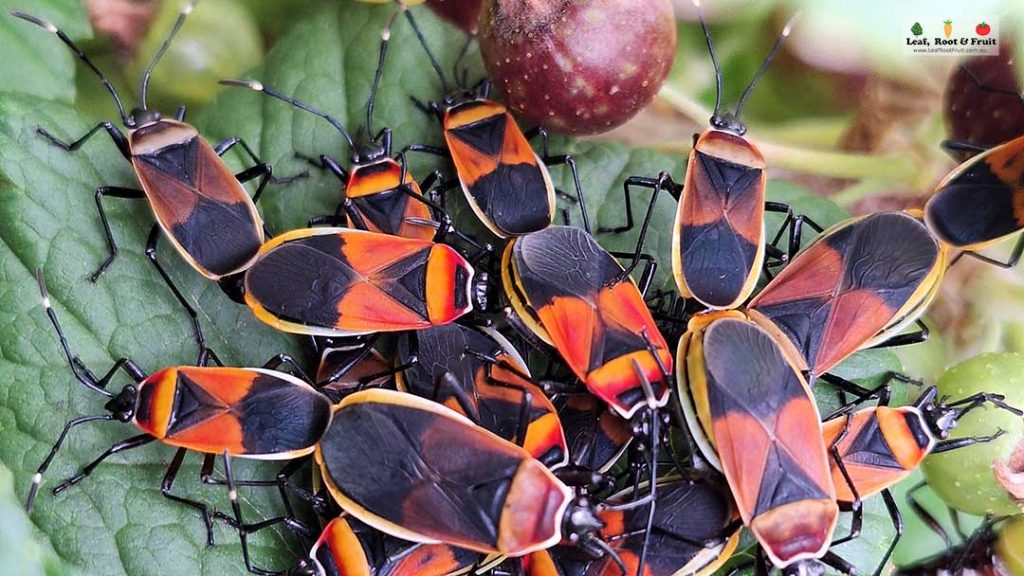
There are a few garden pests that evoke passionate responses from gardeners. Avoiding or controlling these pests can become an obsession bordering on mania. Possums and citrus gall wasp immediately come to mind.
However, I’ve recently discovered another garden pest that some gardeners fixate on. The much-dreaded harlequin bug (Dindymus versicolor) is a foe of many of my readers. Harlequin bugs are sap suckers. They use their proboscis to probe plants, especially fruit, and suck the juices from them. This can lead to shrivelled fruit, cosmetic damage and reduced shelf life.
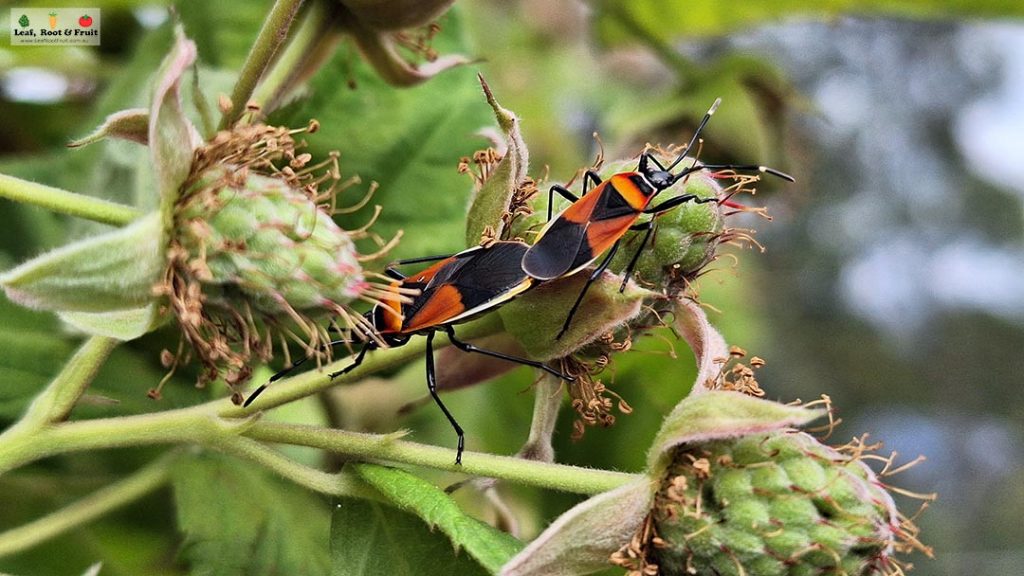
This year harlequin bugs have exploded in numbers in my own garden
I first noticed harlequin bugs in our garden two years ago. I think they may have arrived on a potted plant when I was planting out my new netted enclosure. Before that I hadn’t spotted them in our garden.
I expected them to build up in large numbers the following spring. But the unusually cold weather in late 2022 must have kept them in check. I hardly noticed them again until they took off in autumn this year. They had a preference for raspberries, in particular a yellow variety called Yarra Valley Gold.
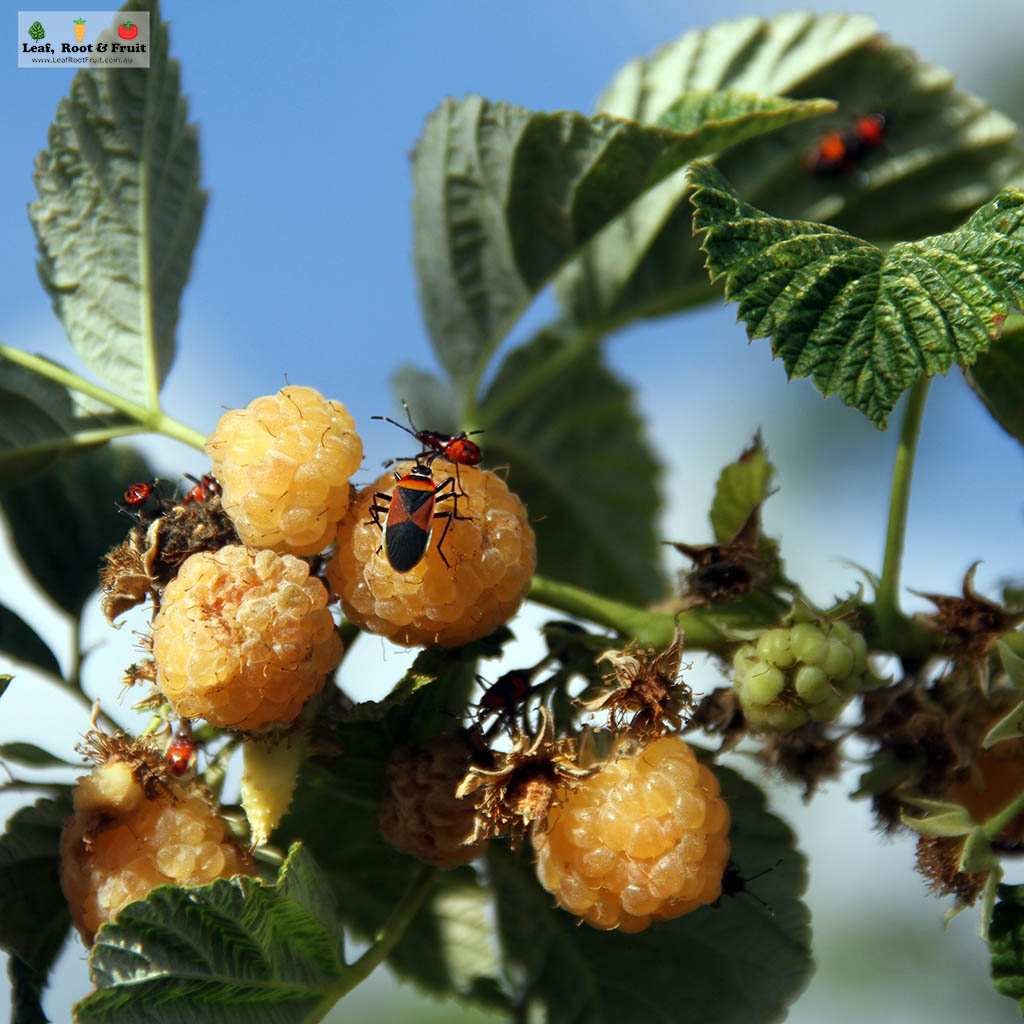
The warm spring this year has seen their numbers explode. They are all over the garden, but particularly the berry patch. They are massing on the raspberries, eagerly awaiting the ripening fruit. They’ll use their proboscis to pierce the raspberries and suck out the juice. They’ve already been hard at work on the ripening redcurrants. All the early ripening redcurrant fruit was sucked dry, shrivelled and fell to the ground. Everywhere I look there are mating beetles, perched bum to bum.
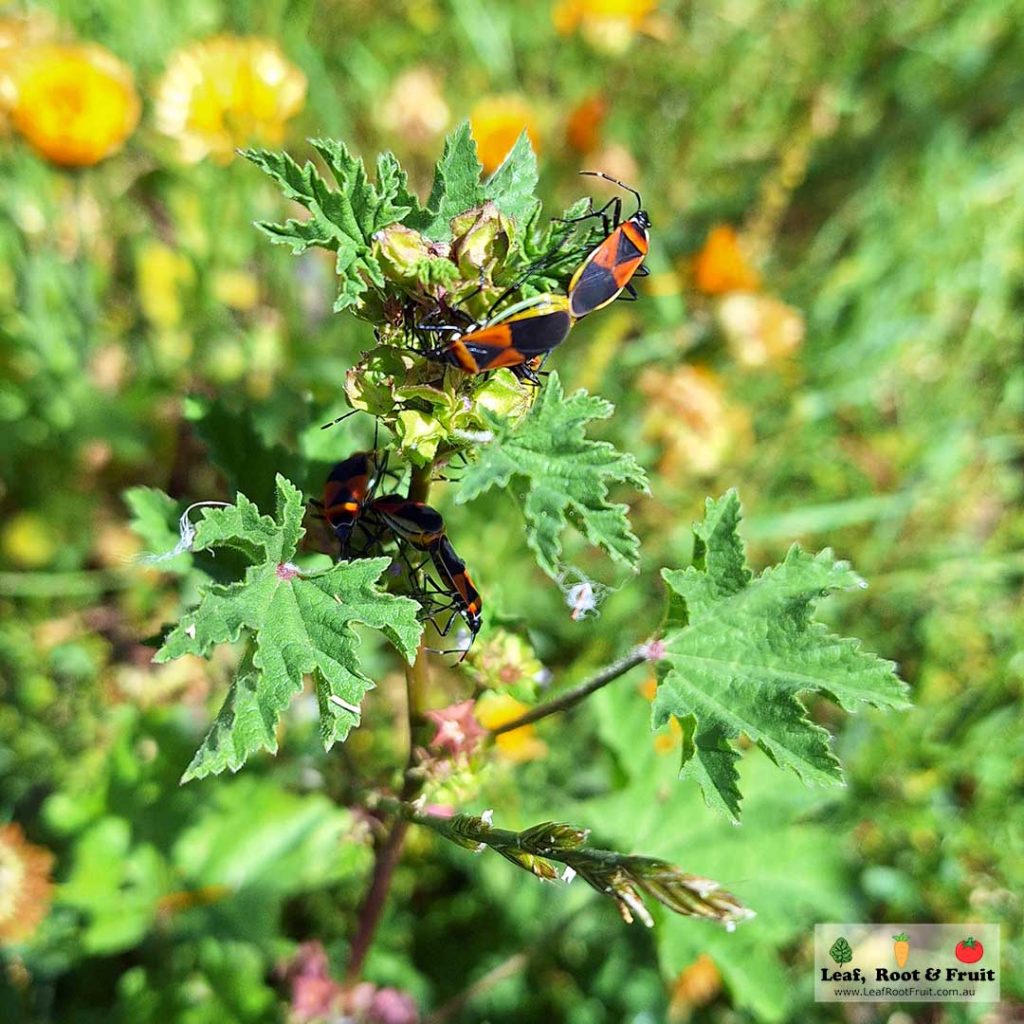
I don’t have much experience with this garden pest. So I took to social media to ask my readers for advice on dealing with them. There were plenty of helpful tips. Some folks focused on removing host plants. An internet search will tell you that marshmallow (Malva parviflora) is the main plant they overwinter on. We don’t have this “weed” growing on our property much. Since I first noticed the harlequin bugs, I have been pulling the occasional random plant out, but there are hardly any marshmallow plants to start with.
I have noticed a whole range of plants that harlequin bugs are attracted to
As I mentioned above, raspberries are where I first noticed the bugs. In large numbers they are definitely causing a fair bit of damage to the ripening fruit on my raspberry plants. They are also on the strawberries, but not causing much damage.
I’ve observed plenty of mating beetles congregating on silverbeet and chard. Rhubarb is another plant they take up residence in.
They are slowly migrating to the various fruit trees on the property, but of these, the avocado trees have them in the biggest numbers.
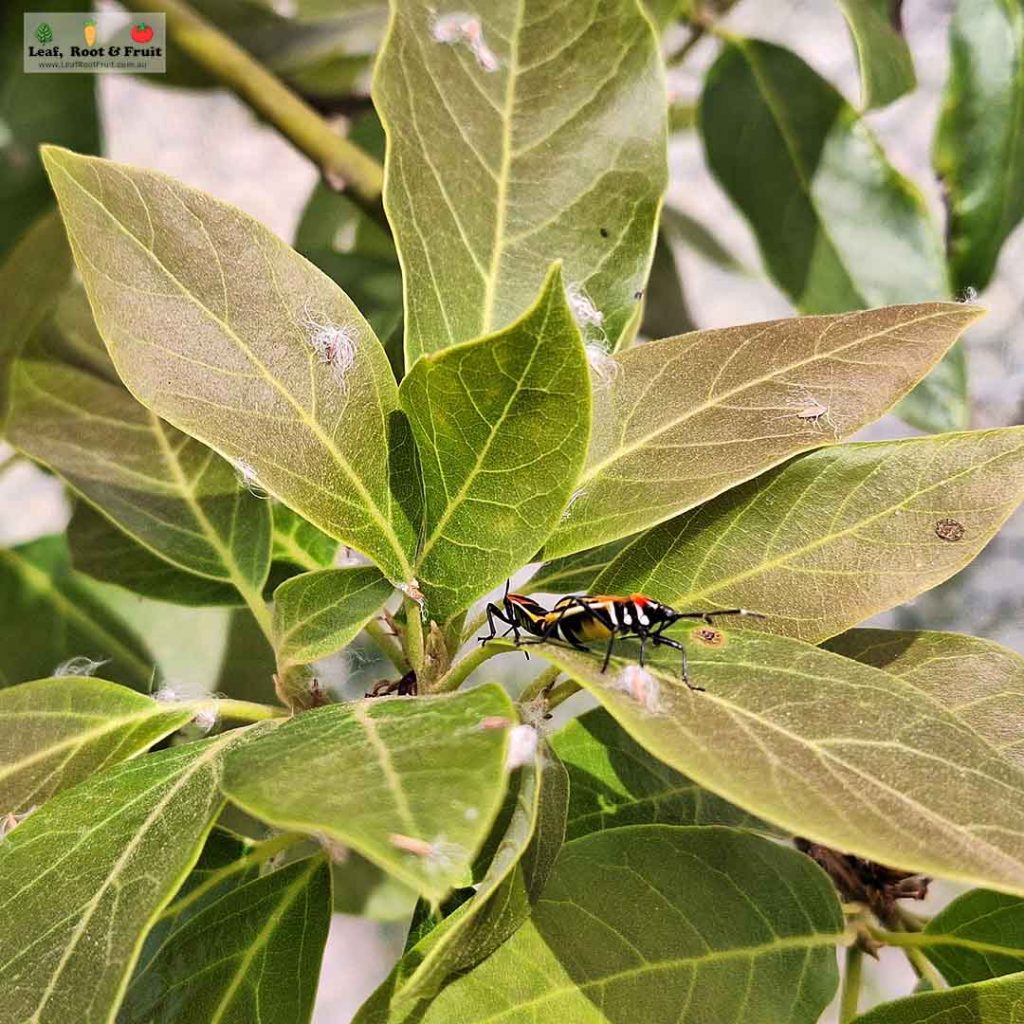
Many flowering plants attract the bugs. Last autumn I noticed they congregated on the echinacea blooms. Hollyhocks also attract them.
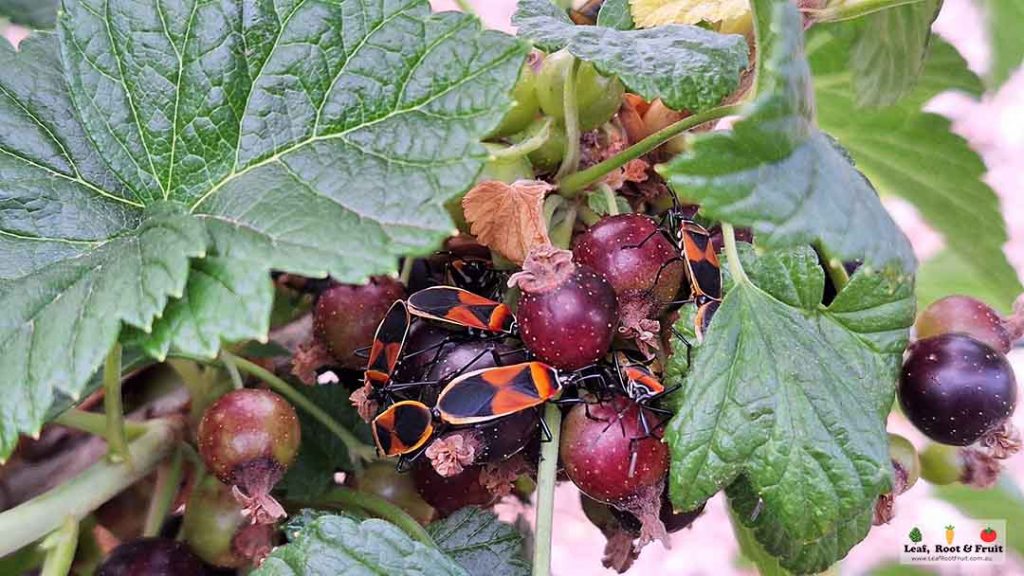
The plants they seem most attracted to are the blackcurrants. The fruit is just beginning to develop some colour and I’m watching closely to see how badly affected the crops become.
Touch wood, so far the blueberries and gooseberries don’t seem to have any beetles on them!
What’s the best strategy for dealing with harlequin bugs?
Most of the responses to my social media post focused on population control using soapy water. This involves making up a strong solution of dishwashing detergent (some folks recommended as high as 50% dishwashing detergent to 50% water).
Some people use it as a spray. Others prefer to flick the beetles into a bucket of water. If I was going to use the soapy water method then I would choose to flick them into a bucket. That way there’s less chance of affecting other insects in my garden ecosystem.
I’ve also been told that guinea fowl are particularly good at controlling harlequin beetles. Chickens are not. Harlequin beetles taste TERRIBLE. I know this because I’ve accidentally eaten one concealed inside a raspberry. Lesson learnt. I inspect every raspberry carefully now, so that it NEVER happens again. But I can now understand why chickens, wild birds and other wildlife don’t like to eat them. The guinea fowl must have some funky taste buds!
My options for controlling harlequin bugs in the garden
I live on a six-acre property. My productive space, which includes the berry patch, netted enclosure, edible forest gardens and market garden covers around half an acre (2000 square metres). Making daily patrols of the whole garden to flick harlequin bugs into a bucket of soapy water is not practical. Some of you mentioned that you make twice daily patrols! Even if I could convince the interns to undertake this task, that still wouldn’t leave much time for actual gardening. For now, this method is being parked.
Option one: Do nothing!
My usual approach to pest control is to wait. An abundance of ripening berries has created an abundance of food for the harlequin bugs. Harlequin bugs are native to Australia. So, in time, I’m hopeful that their natural predator will also breed up to curb their rampant, exponential growth curve. Will it be parasitic wasps? Frogs? Or something else? Check out this post for more information on population dynamics and why most forms of pest control are a waste of time.
I’m already hopeful that this “problem” may not actually be that much of a problem. Last week the harlequin bugs were focused on the ripening redcurrants and none of the fruit was becoming fully ripe before shrivelling and falling from the plant. This week, there’s not a single harlequin bug to be found on the redcurrants. They’ve all moved on to the blackcurrants.
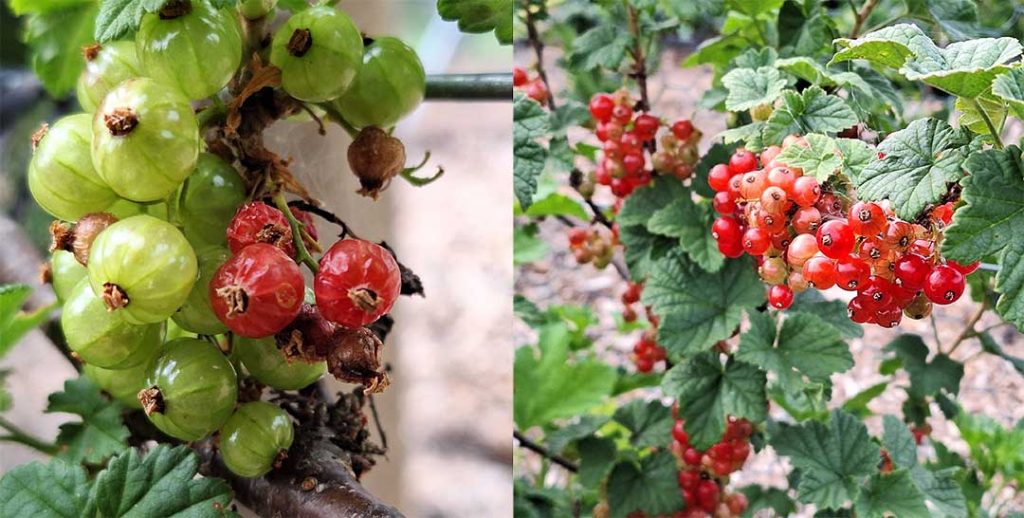
They are causing significant damage to the first raspberries of the season, but hopefully in a few weeks the number of ripening raspberries will be too many for the harlequin bugs to damage all of them. Then I should be able to harvest some raspberries in good condition.
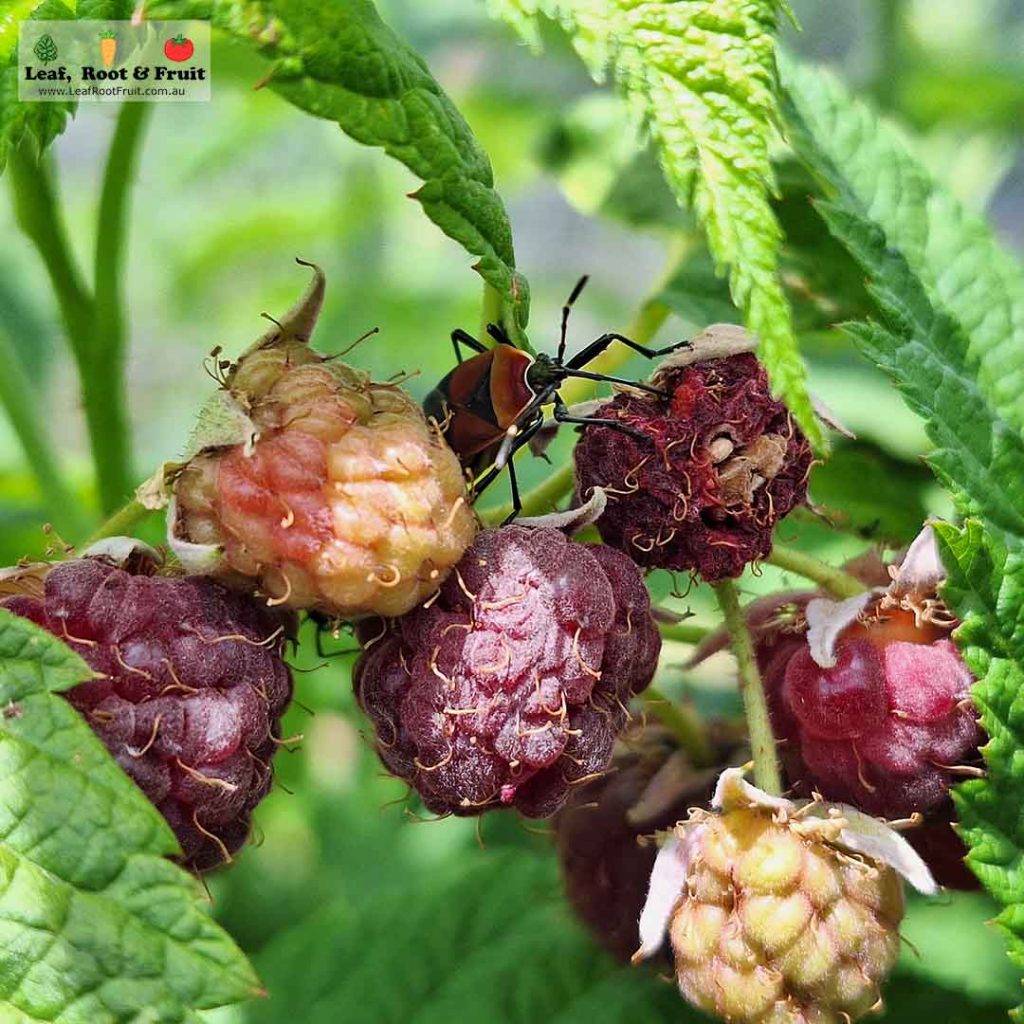
There aren’t any beetles on the blueberries so at least we should have a good crop from them this year.
Many other gardeners are noticing an explosion in harlequin bugs this year. The mild winter perhaps didn’t reduce the numbers enough and they have quickly bred up in the mild spring. Perhaps in future years they won’t be such an issue. I’m also hopeful that the forecast hot and dry summer might slow their growth. Time will tell.
Option two: Guinea fowl
Apparently guinea fowl will eat harlequin bugs. But guinea fowl would probably also eat the berries. I might need to be a bit strategic if I include them in the netted enclosure, allowing the guinea fowl to forage for the beetles only in winter and early spring when there are no berries to eat.
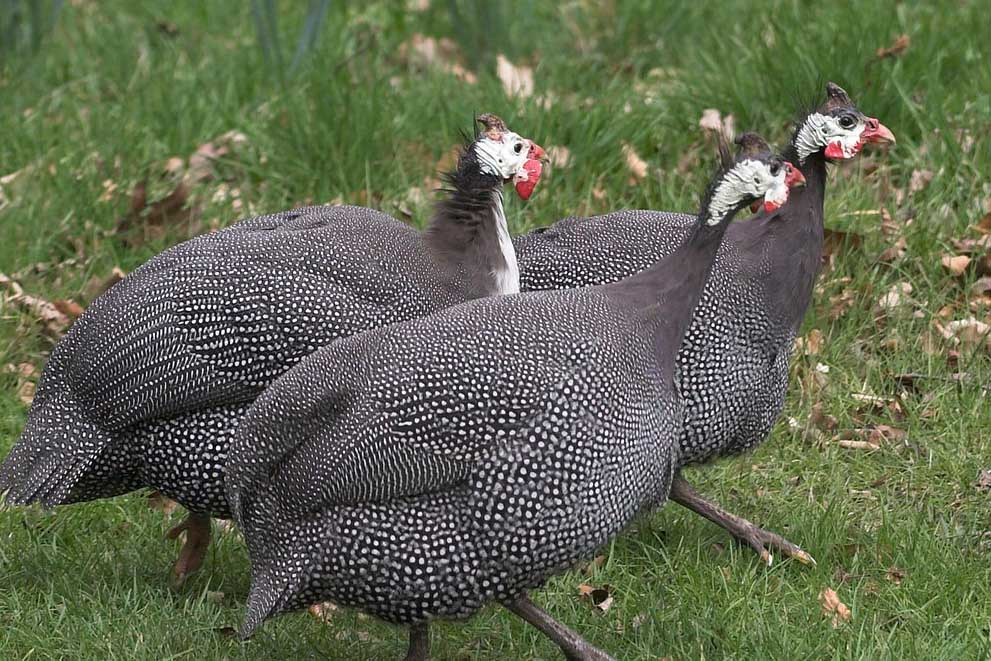
I have internal fencing to control when and where the chickens can forage. I assume I could clip guinea fowl’s wings, as you can clip chickens’ wings? This would enable me to keep them out of the berry patch. It would reduce their effectiveness in controlling the harlequin beetles there, but at least the blueberries would be safe! They could spend the summer foraging in the orchard section of the netted enclosure. Once the berries are finished, I could let the guinea fowl in to do their work.
Guinea fowl are noisy and flighty and I’m not in a rush to get some. Before committing to introducing them into the netted enclosure system, I’d need to answer a few questions:
- Which berries will they eat (and not eat)?
- Will they eat the fruit such as cherries, apples, pears, apricots and peaches?
- What would be the right number to introduce? Not enough and they won’t control the harlequin beetles. Too many and I might not have any berries or fruit. Would two suffice? Do I need a whole flock?
- Do guinea fowl have any other specific requirements beyond those of chickens that I need to be aware of?
Option three: Quail
This one is a long shot, but “Chris” mentioned in a social media comment recently:
“At one point on a different property I kept quail and they did seem to help control the bugs. They were a larger form of quail, like a bobwhite size.”
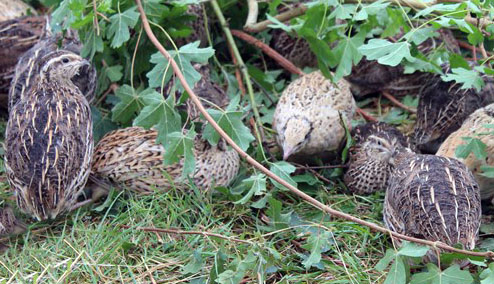
If certain types of quail can control the harlequin bugs, this would be a fantastic option. Quail are much smaller than guinea fowl and much less noisy. There are many different types of quail that can be kept domestically, including:
- Japanese quail
- Bobwhite quail
- California quail
- King quail.
I suspect that some types of quail are better suited to the task than others. I now need to find out for the different quail options:
- Will they eat harlequin bugs?
- Will they eat berries, and which ones?
- What modifications would I need to make to keep them inside the netted enclosure? It has a few small gaps.
- What else do I need to know about keeping quail?
I really want the quail option to be a viable one. If anyone has any wisdom they can share with me, that would be great. I’d love to hear from you.
Update Feb 2024: Where have all the harlequins gone?
Remember my slight panic at the huge outbreak of harlequin beetles in my garden this spring? They were everywhere and I put out a call on social media for help in deciding the best course of action. There was a huge response and I considered soapy water, guinea fowl and quail among the arsenal of control options. They all seemed like great solutions, but all had their drawbacks.
Instead, I opted for a lazy approach. I did nothing. It’s worked for every other pest I’ve had in my garden, so why not relax about the harlequins?
Nevertheless, I was concerned, as quite a few of my readers suffered “harlequin mania” and obsessed over controlling these garden pests. We have a huge productive garden and this summer there’s an abundance of most fruit and vegetables. The stakes were high, and I was nervous. I didn’t want to lose all my precious fruit.
Guess what? Despite my lazy approach, there’s now hardly a harlequin bug to be seen!
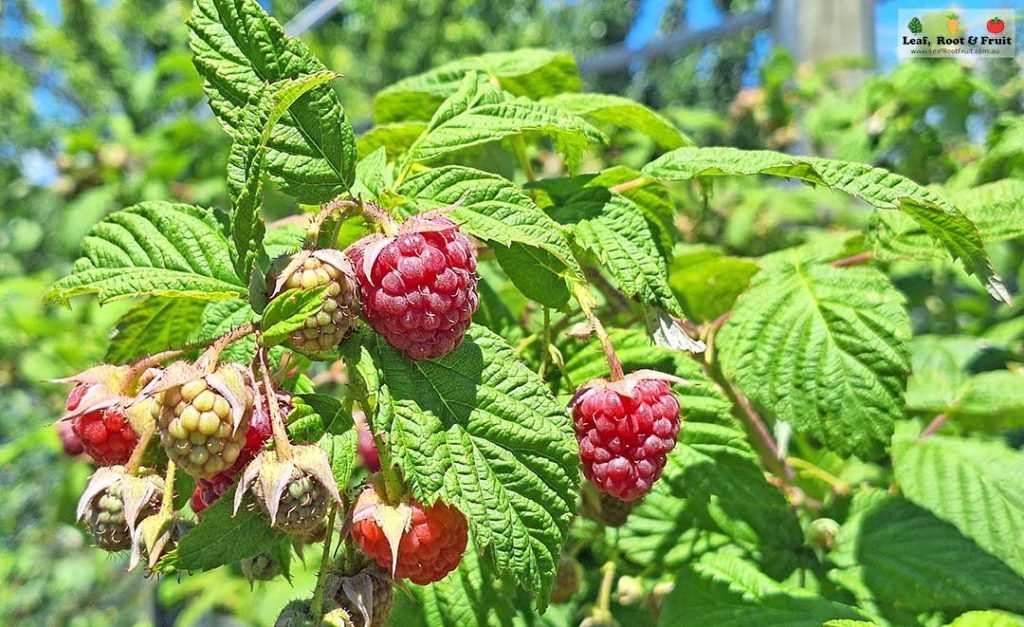
Just like every other organism in nature, harlequin bugs go through boom and bust cycles in their populations. The dry and mild spring must have created ideal conditions for them to breed up. Perhaps the high humidity has been their downfall this summer? Maybe predators have bred up? Whatever the reason, their impact has been minimal. Some of the early raspberries were shrivelled from their feeding, but I’ve picked over 13 kilos of raspberries since then. So the harlequins haven’t really been an issue.
I wonder if all those control methods really work? Or rather, does the natural decline in populations coincide with all that hard work of the harlequin mania sufferers? Perhaps it makes the control methods appear to work, but is really just a waste of time.
Lesson learnt: stay the course. Implement a resilient garden ecosystem anchored with a diverse array of flowers, and get the hell out of Mother Nature’s way. Any temporary blips in the ecosystem soon return to balance with a good dose of patience.
Read more about all of this in my article on pest and predator dynamics.
I’ll continue to update this post as my approach to the harlequin bugs evolves. Stay tuned!
What’s your take on harlequin bugs. Do you have a sure-fire tip for reducing their impact on your crops? Should I be panicking? Do I need to act? Or can I just wait it out for nature to restore the balance? Please let me know in the comments section below.


I know of two Guinea fowl that need a holiday. I was plagued with Harlequin bugs three years ago both in my netted enclosure and the general garden. I was given two fowls “just because”. I didn’t know about their bug eating abilities but I observed how quickly the bugs disappeared not only from the netted enclosure but also from the general garden. The bugs were always massed on the rhubarb in the netted enclosure. The Guinea’s aren’t let out from the enclosure. I haven’t noticed them eating anything they shouldn’t but they occasionally dig up some bulbs or small raspberry plants. They are the “bug busters”
Thanks for the tips. I’ll be in touch if I decide to give the guineas a go. I like the idea of a trial.
I live in Mount Gambier we have had little to no rain yhis summer and no humidity.. the little blighters have decimated my tomato crops. We used to have marshmallow but removed it all. They have now moved onto my lemon blossoms …. Going to try the 50/50 soap as i dont have time to push the little buggers into a bucket
That’s interesting. I wonder what’s different about your garden versus mine then?
Thanks for sharing your observation. I hope you get on top of them soon.
Happy gardening
Duncan
Hi. Interesting article. For the first time I have been inundated with baby harlequins. Yes they are all over the raspberry patch. Plus I do have a mallow ‘tree’ growing close by. I’ve just sprayed pyrethrum on the baby critters crawling all over the ground and it has killed them. Had some quail eggs given me but unfortunately they were not fertile so my experiment to have them in the garden to eat solely bugs didn’t eventuate. I’ve been told that buying adult quails doesn’t work as they need to be locked up for ages till they know it’s their new home. But I could be getting confused with Guinea fowl in that respect. I hope to hear how you go with your research. Best of luck. Teresa
Hi Teresa,
Thanks for sharing your experience with the harlequins. I hope their numbers soon diminish for you.
Happy gardening
Duncan
I don’t know about you, but they have exploded in my garden in the last couple of weeks! And I can absolutely understand why gardeners become obsessive, I am out every morning flicking them into a bucket! I hate the little things and will try anything to get rid of them. Have you heard from anyone about the quail?
Hi Yarni,
Sorry to read this. They’ve just started increasing in number this week with the high humidity. They tend to not like the hot dry of summer in my part of the world.
A few folks have discussed the quail option with me, but I am yet to ascertain if the quail will actually eat the harlequin bugs. More research required!
Happy gardening
Duncan
How did you go this year? Did they reappear?
Hi Julie,
They were in low numbers this spring but then disappeared over the summer. I’m observing a pattern of them preferring mild weather, but more importantly high humidity/moisture. Now that we’re transitioning to autumn, the night time humidity is increasing and I’m noticing many juvenile harlequins on the rampage. I think really wet springs exacerbate them, but they tend to go dormant during dry summers.
At this stage they still have never reached high enough numbers to require me to panic. Like every other pest, they are seasonal and their numbers will ebb and flow.
Happy gardening
Duncan